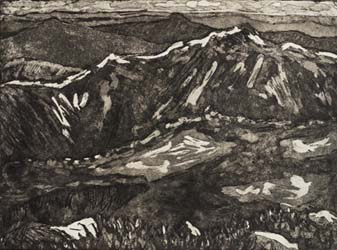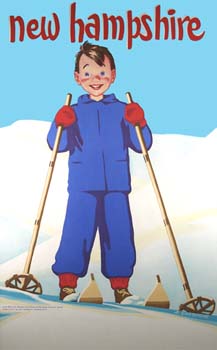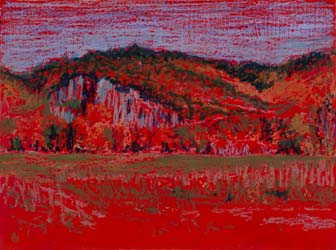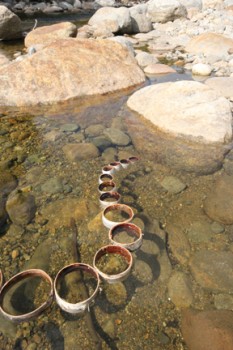Section 6: Contemporary Women Artists
Alice E. Cosgrove of Concord worked for the New Hampshire State Planning and Development Commission to promote tourism. She created “Chippa Granite,” a boy who first appeared in posters advertising New Hampshire ski resorts in 1953. Her work also included a postage stamp with the Old Man of the Mountains, the design on the NH inspection sticker, and modern representations of New Hampshire tourism that often focused on the beauty of the mountains.
- “Blair Folts, Lions Head, 5/7, 1992. Lithographic print, created on paper, 9 3/4 x 12 1/2 inches. Photograph by John Anderson. Courtesy of Peter Rowan and June Hammond Rowan.”
- ” Alice Cosgrove, New Hampshire, part of “”Chippa” Granite silkscreen print series, 1954. Issued by NH State Planning and Development Commission. Courtesy of the New Hampshire Historical Society. www.nhhistory.org”
“Painting on location, I use gestural marks to explore the transience of the natural world. I choose colors and marks that best express random movement and the passage of time. In my paintings, classical structure sits on the edge of abstraction. Standing in the meadow, my vision took in the wide open space of the bare Cathedral Ledge. Vibrant hues surrounded the exposed rock, framing it with neighboring mountains. On October 17, the left panel was painted, while in the field that day, dogs barked and ran wild. The panel’s crimson color field, with associations of earth’s warming, served as the backdrop. There was enough time for my mark making to capture form and light, before a storm blew my painting to the ground. Returning October 19, the weather permitted the right panel to be painted. The presence of the meadow, rock formations and brilliant colors competed for my attention, as erupting beauty of daylight transformed to dusk.” Betty Brown, 2015
- “Betty Flournoy Brown, Cathedral Ledge Mt. Washington Valley Diptych. Oil on birch panels, 18 x 48 inches. Courtesy of the artist.”
“Scientists say there may be as many as 12 percent of women that perceive millions of colors invisible to the rest of us. Studies have been done on “Super Vision” women who have a fourth cone as opposed to three. Results were found in a paper on color blindness on men in 1948 by Dutch scientist HL de Vries. I do not claim to have this super vision but it makes sense to me as a painter. I have always been asked, do you really see these colors? Sometimes I honestly do, but in a much less intense form. I take the values of color that I see and bump them up a few notches. I have learned from painting outdoors that the manufactured colors from the studio environment are very different from natures. Working outdoors is much more inspiring. Often I will apply an under painting on my paper, using the opposite color that I see. It gives me a jump start into the painting. I do know that I need to practice -paint a lot- to maintain my artistic vision.” Diane Taylor Moore, 2016
- “Dianne Taylor Moore, Mt. Moosilauke—Harvest the Light, 2011. Pastel on paper, 8 x 12 inches. Courtesy of the artist.”
- Mary Cecile Graham. Edmands Col, Mt. Eisenhower (sketch) August 2013. Graphite and chalk on brown paper. Sketch was done “en plein air’ on Mt. Eisenhower. Courtesy of the artist
- Mary Cecile Graham. Edmands Col, Mt. Eisenhower. August 2013, Oil on linen, Mounted on birch panel, 11 x 14 inches. Courtesy of the Artist
Intimate encounters with the wildness and “otherness” of nature is the core inspiration for my work. Exploring the interplay of culture and history in humankind’s relationship with nature and landscape are the motivation and inspiration for my paintings, along with my desire to protect, celebrate, and inspire others with the fragile beauty of the natural world. Mary Graham, 2016
- “Lauren Sansaricq, Crawford Notch, 2015. Oil on canvas, 23 x 33 inches. Courtesy of the artist.”
Lauren Sansaricq grew up in Columbia County, New York, where from an early age she was exposed to both the beauties of the Hudson Valley and, under the teaching of Thomas Locker, to the traditional painting techniques of the Hudson River School. Taking Mr. Locker’s advice Miss Sansaricq received academic training in drawing and painting at the Grand Central Academy of Art in NYC.Today Sansaricq’s work is in collections throughout the country, and is hung beside some of the best American painters of the past. She also teaches every summer on the Hudson River Fellowship, and now resides in the White Mountains.
During her White Mountain National Forest Residency, Kyle Browne used natural materials to create site-specific ephemeral work that responded to the environment; drawing with graphite on paper to capture the shift of movement in time in the forest; and writing intuitive reflections and responses to her work.
- Kyle Browne Birch Portal 2013
- Section 1: The First Pioneers
- Section 2: Women and White Mountain Art
- Section 3: Early Travel in the White Mountains
- Section 4: Women’s Clothing
- Section 5: Women Taking the Lead
- Section 6: Contemporary Women Artists
- Section 7: Women in the 20th and 21st Century
- Section 8: American Women’s History Interviews
- Return to Exhibition Info








